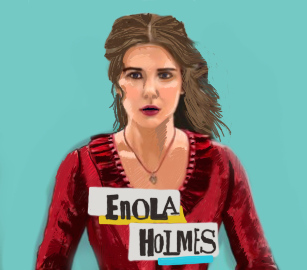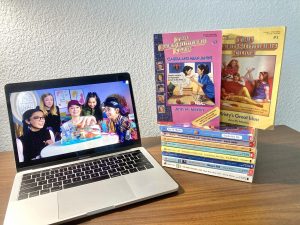“Enola Holmes” shows that women are more than just pretty faces

“Enola Holmes” crushes sexist gender expectations with a powerful, teenage female protagonist.
October 19, 2020
Enola Holmes is the strong, teenage, female lead who cleverly shows both the film’s patriarchal society and today’s misogynists that women are so much more than just dolls of society.
“Enola Holmes” was released on Netflix on Sept. 23, 2020. As the name suggests, the exciting period piece is centered around Enola Holmes (Millie Bobby Brown, who also co-produced the film with her sister), the young, clever and quick witted sister of famous detective Sherlock Holmes (Henry Cavill) and the lesser-known Mycroft Holmes (Sam Claflin).
On the morning of her 16th birthday, Enola finds a mysterious gift from her mother Eudoria (Helena Bonham Carter), who has gone missing.
Following Eudoria’s clues, Enola runs away to London, where she meets Tewksbury (the gorgeous Louis Partridge), an oblivious and somewhat arrogant nobleman (the “missing” marquess.) Throughout the film, Enola juggles searching for her mother, dodging her brothers and escaping Tewksbury’s unknown assassin.
Enola’s defiance of expectations is evident in the way she openly opposes the dress standards of her time. In Victorian England, women were expected to wear tight corsets (or as Enola would call them: “symbol[s] of repression to those who are forced to wear [them]”), large hoop dresses and mounds of makeup. Enola blatantly disregards this standard; in the first few scenes of the movie, she wears her hair down in messy waves, flaunts rolled-up sleeves, and roams the woods on her bike with dirt all over her. She is what outdated language would label as a “tomboy,” a term developed in the 16th-century (now considered offensive) to describe girls who were rowdy and masculine. I would say the word “badass” is a better label.
Because of Enola’s unconventional appearance, Mycroft and Sherlock do not recognize her at the train station when they return home after Eudoria’s disappearance. In fact, Mycroft looks at Enola with disgust even after he realizes that the “creature” waiting for them is his sister. His first question for her is “Where are your hat and gloves?” which, frankly, is a pretty accurate representation of what men believed women’s priorities should’ve been at the time — cosmetics, nothing more.
Thankfully, Enola responds by saying “Well, I have a hat. It just makes my head itch. And I have no gloves,” which provides a perfect — and quite humorous — disregard to the supposed embarrassment Mycroft intended to instill in her. Ironically, Mycroft is the only one flustered after the interaction.
If you thought Enola was a “Actually, I’ll wear whatever I want!” kind of girl, you’re not wrong. But she does not employ this attitude for much longer than the first quarter of the movie. Once Enola arrives in London, she purchases a bright red, ruffled dress , and puts her hair up in a neat bun. This may seem contradictory to her previous antics — but her seemingly sudden conformation to gender norms is perhaps an even more compelling testament to how she crushes the societal standards intended to coerce her into submission.
Enola knows that Mycroft would send someone to look for a dirty, “unfeminine” child in London, so she becomes what he would never expect of her — “(gasp).. a lady!” This disguise allows her to use society’s collective misogynistic view of women against Mycroft and escape capture. It’s a brilliant plan, and it’s executed impressively by Enola.
But she doesn’t stop there with the table-turning.
Not only is Enola able to successfully run, fight, and charm at the same time in a heavy swath of fabric, but she also leverages her newly acquired feminine attributes to her advantage. Let’s go back to the infamous corset. Although Enola refers to it as a “symbol of repression,” she takes ownership of the cage-like contraption by choosing to wear it as a sort of armor.
Using the corset, she is able to slyly hide the money that her mother left her, prevent a fatal stabbing from Tewksbury’s crazed assassin, and do so much more. In my opinion, both Mycroft and Enola got what they wanted. Enola looks like the refined woman Mycroft wants her to be, and she can still do all the things girls are not “supposed” to do at the same time!
Besides the obvious physical ways that Enola thwarts social norms, one of the less noticeable yet most fascinating plot details that demonstrates female independence is the intentional exclusion of a romantic development of Enola and Tewksbury’s relationship throughout the film. It is annoyingly commonplace to expect some type of romantic storyline in most movies involving teenagers or even more generally, two heretosexual leads of the opposite sex. Love stories sell, and the entertainment industry exploits that to the point where the same plots are being repeated over and over again. How many rom-coms can Netflix make with Noah Centineo as the male lead until people start getting bored? While I don’t know the answer to that question, “Enola Holmes” is pleasantly unique in the sense that it was spared from Netflix’s tendency to Noah Centineo-fy anything they can.
Yes, there are definitely some flirtatious undertones that characterize Enola and Tewksbury’s relationship. Enola even admits that she’s grown fond of Tewksbury in his absence when she finds him at the London market.
But it’s hard to generalize her interactions with him as solely affectionate. Enola expresses a disinterest to his inviting flirtations multiple times and even once notices Tewksbury gazing at her in awe and quickly shuts him down: “If you don’t stop looking at me like that, I’ll murder you myself.” In the end, their relationship is left ambiguously defined. There is no confession of feelings nor a commitment to just friendship.
Perhaps the only thing the ending leaves us with to analyze in relation to Enola and Tewksbury’s relationship status is Tewksbury’s parting kiss on Enola’s hand. But I don’t even think that can be definitive evidence of anything. Sure, one could say the physical contact of a kiss (regardless of location) passes platonic boundaries. On the other hand, one could make just as fair an argument that the act of kissing a woman’s hand was just common chivalry in Victorian times.
The lack of a central romance plot was strategically calculated. In an interview with Press Trust of India, Partridge explained that there was initially supposed to be a kissing scene at the end of the movie, but it was omitted when it came to the day of shooting to “leave it up in the air” for the audience to speculate.
Had the producers put a label on Enola and Tewksbury’s relationship, it would have given the audience something to find certainty in and swoon over, most likely overshadowing the more important parts of the plot, such as the implications of the reform bill. Ignoring the urges to throw in a superficial, and probably unrealistic, romance plot grants deserved respect to the issues in the movie that the audience should actually care about.
If the absence of a love story is not enough, the producers also make it clear that Enola is the one who leads her and Tewksbury’s relationship, a stark contrast to traditional Victorian norms and even some expectations held of male-female relationship power dynamics today. From their initial encounter on the train, Enola is evidently the stronger one (both intellectually and physically), and she essentially controls Tewksbury. This manifests itself quite literally, for example, when Enola convinces Tewksbury to jump off a train with her. Through Tewksbury’s almost goofy and playful demeanor, the producers communicate the meaningful concept that it in fact can be the man who relies on the woman, contrary to the way dependence is typically portrayed in movies.
And it’s damn right in this case — Tewksbury would not be alive without Enola. She helps Tewksbury cut his hair to disguise himself, saves him from being caught multiple times, and oh, she also cracks the biggest political conspiracy and assasination attempt in all of England, effectively putting an end to the constant possibility of Tewksbury’s death. It may be wrong to idolize the dramatic role reversals here, but it’s honestly just extremely refreshing to see filmmakers accurately depicting the girl coming to the guy’s rescue for once.
“Enola Holmes” is not a revolutionary feminist film that solves sexism and misogyny. Unfortunately, I don’t think any single film will have that power — and it’s dangerous to believe those who try to convince others of the contrary. Yet, “Enola Holmes” still gives the audience an exhilarating adventure and the opportunity for young girls who experience it to understand that they can be their own people, not just society’s dolls. As Enola Holmes would say, “My life is my own. And the future is up to us.” Hopefully the girls are listening.





